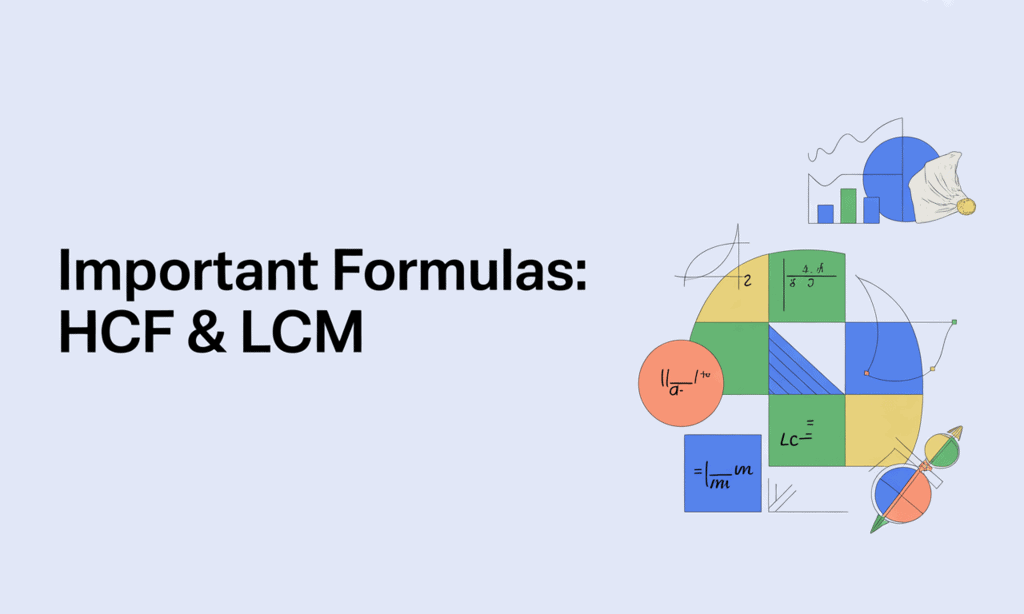Important Formulas: HCF & LCM | Quantitative Aptitude (Quant) - CAT PDF Download
| Table of contents |

|
| Meaning and Basics |

|
| Prime Factorisation Method |

|
| Short-cut Method |

|
| Relationship Between HCF and LCM |

|
| Important Results and Formulas |

|
| Shortcut Tricks |

|
| Solved Examples |

|
| Summary Table |

|

Meaning and Basics
- HCF (Highest Common Factor): The greatest number that divides two or more numbers exactly.
- Also called GCD (Greatest Common Divisor).
- LCM (Least Common Multiple): The smallest number that is exactly divisible by two or more numbers.
Prime Factorisation Method
Let two numbers be expressed as:
a = p₁ˣ¹ × p₂ˣ² × p₃ˣ³ × …
b = p₁ʸ¹ × p₂ʸ² × p₃ʸ³ × …
Then,
For finding HCF → take lowest powers of common primes.
For finding LCM → take highest powers of all primes.
Short-cut Method
(i) Using Division Method for HCF:
- Divide the larger number by the smaller one.
- Replace the larger number with the remainder.
- Continue dividing until the remainder = 0.
- The last non-zero remainder is the HCF.
(ii) Using Product Formula for LCM:
Once HCF is known, use: LCM = (Product of numbers) ÷ HCF.
Relationship Between HCF and LCM
- For two numbers a and b:
HCF × LCM = a × b - For three numbers a, b, and c:
HCF × LCM = (a × b × c) ÷ (HCF of pairwise combinations) - LCM of fractions = LCM of Numerators / HCF of Denominators
- HCF of fractions = HCF of Numerators / LCM of Denominators
Important Results and Formulas
| Concept | Formula / Explanation |
|---|---|
| Relation between two numbers | HCF × LCM = Product of the numbers |
| Relation between three numbers (co-prime) | HCF × LCM = Product of the numbers |
| When HCF and one number are given | LCM = (Product of numbers) ÷ HCF |
| When LCM and one number are given | HCF = (Product of numbers) ÷ LCM |
| HCF of fractions | HCF = HCF of Numerators ÷ LCM of Denominators |
| LCM of fractions | LCM = LCM of Numerators ÷ HCF of Denominators |
| If two numbers are co-prime | HCF = 1, hence LCM = Product of numbers |
| Ratio of two numbers | Ratio = a : b = HCF × (p : q), where p, q are co-prime |
| HCF of perfect squares/cubes | Always a perfect square/cube, respectively |
| Product of HCF and LCM of fractions | = Product of the given fractions |
Shortcut Tricks
1. When numbers are small:
- List their multiples/divisors manually.
- Pick the smallest common multiple → LCM.
- Pick the greatest common divisor → HCF.
2. When numbers are large:
Use Prime Factorisation or the Division Method.
3. If LCM and one number are known:
Other number = (HCF × LCM) ÷ Given number
Solved Examples
Example 1: Find the HCF and LCM of 12 and 18.
Sol:
Prime factors:
12 = 2² × 3¹
18 = 2¹ × 3²HCF = 2¹ × 3¹ = 6
LCM = 2² × 3² = 36Verification:
HCF × LCM = 6 × 36 = 216 = 12 × 18
Example 2: Find the LCM and HCF of fractions 3/4, 5/8, 7/12.
Sol:
HCF = (HCF of 3, 5, 7) ÷ (LCM of 4, 8, 12) = 1 ÷ 24 = 1/24
LCM = (LCM of 3, 5, 7) ÷ (HCF of 4, 8, 12) = 105 ÷ 4 = 105/4
Summary Table
| Topic | Formula / Concept |
|---|---|
| HCF × LCM = Product of two numbers | Always true |
| For three co-prime numbers | The same formula holds |
| HCF of fractions | HCF of numerators ÷ LCM of denominators |
| LCM of fractions | LCM of numerators ÷ HCF of denominators |
| HCF of decimals | Convert to integers and proceed normally |
| LCM of decimals | Convert to integers, find LCM, then divide by the appropriate power of 10 |
EduRev Tip: Always check divisibility and verify using the HCF–LCM product rule.
|
167 videos|238 docs|95 tests
|
FAQs on Important Formulas: HCF & LCM - Quantitative Aptitude (Quant) - CAT
| 1. What is the Prime Factorisation Method and how is it used to find HCF and LCM? |  |
| 2. Can you explain the relationship between HCF and LCM? |  |
| 3. What are some important results and formulas related to HCF and LCM? |  |
| 4. What are some shortcut tricks for calculating HCF and LCM? |  |
| 5. Can you provide an example of how to solve HCF and LCM problems? |  |














